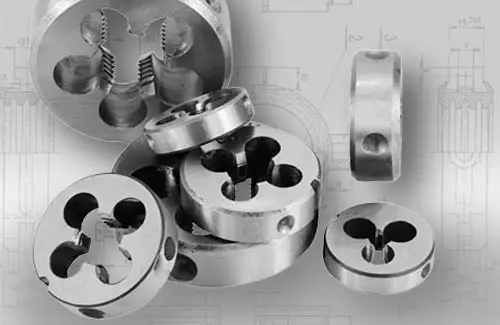The regular price is the current manufacturer's recommended price! FREE shipping for orders over EUR 41,67 within CZ+SK (PPLparcel)

Round dies are used in the production and repair of external threads on shafts. To begin the selection, it is advisable to determine which type of die is best for the desired application.
Dies can be selected according to the use on the machined materials:
CV – carbon steel
Soft structural and unalloyed steels with a strength of up to 500 N/mm2
Pure aluminum without additives and alloyed
Copper without additives and copper alloys with short and long chips
Zinc and its alloys
HSS – high-speed steel
Soft structural and unalloyed steels with a strength of up to 500 N/mm2
Free-cutting, structural and tempered steels with a strength of up to 800 N/mm2
Unalloyed cast steels
Gray, ductile and malleable cast iron
Pure aluminum without additives and alloyed
Copper without additives and copper alloys with short and long chips
HSSE – high-speed cobalt steel
Free-cutting, structural and tempered steels with a strength of up to 800 N/mm2
Unalloyed cast steels
Gray, ductile and malleable cast iron
Pure aluminum without additives and alloyed
Copper without additives and copper alloys with short and long chipping
Zinc and its alloys
HSSE-VA – high-speed cobalt steel with teeth ground for STAINLESS STEEL
Tempered steels with strength up to 1000 N/mm2
Tool steels in natural state
Unalloyed cast steels
Gray, ductile and malleable cast iron
Stainless and heat-resistant steels with strength 600 - 1000 N/mm2
Another selection criterion is the type/profile of the thread:
M / Mf - metric thread coarse / fine
G - pipe thread
BSW/BSF - Whitworth thread coarse / fine
UNC/UNF/UNEF – American unified thread coarse / fine / very fine
UNS – American unified thread special
Pg – armoured thread
Dies are most often produced with circular circumference, for clamping in hand-held taps. You can also find hexagonal dies, which can be clamped, for example, in the jaws of a vice, or inserted into socket heads.
For specific manufacturing operations, dies of different sizes and thread pitches can be produced, possibly with a surface treatment by oxidation or another coating on request.
We write about choosing the right hand tap here.
More articles:
Jak vybrat správný ruční závitník?
Jak nabrousit vrták
Testy vrtáků s novou geometrií
Brusný a řezný kotouč: Klíčový nástroj pro efektivní opracování materiálů
Testy vrtáků s novou geometrií